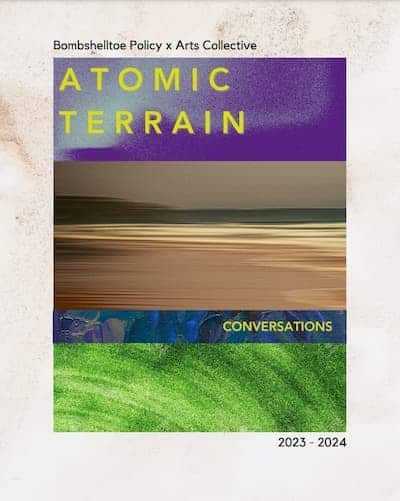How can we create scholarship frameworks and systems of support to better connect nuclear policy and environmentalism? This question was at the heart of Atomic Terrain, the recently released agenda of research created through a series of workshops and roundtables attended by individuals representing creative, environmental, anthropology, and nuclear policy fields. Aditi Verma, a professor of nuclear engineering and radiological sciences and Fastest Path to Zero Initiative team member was among the nuclear policy experts.
The group was brought together by Bombshelltoe Policy x Arts Collective founder Lovely Umayam, a self-described “budding nuclear policy wonk rooted in activism and art.” Bombshelltoe was founded with the intention of presenting alternative narratives and visuals to broaden the emotional spectrum surrounding nuclear issues. The aim is to encourage a shift in public reactions, moving from fear towards feelings of inspiration, curiosity, resilience, and creativity.
Atomic Terrain represents a pioneering effort to break down the barriers between nuclear security and environmental stewardship. By fostering collaboration, mutual respect, and a commitment to experimentation, this interdisciplinary initiative charts a course toward a more integrated and holistic approach to address the complex challenges at the intersection of nuclear policy and environmentalism. The agenda promises to shed light on the insights gained from the collaboration and pave the way for a more interconnected future.
“More scholars recognize the cross-cutting nature of nuclear security and environmental issues as we see how floods, wildfires, and sea-levels rising threaten nuclear-related facilities and superfund sites, but the dialogue seems to be ad hoc, with expertise responding to environmental crises as they unfold,” said Umayam. “Atomic Terrain is about proactive research, building relationships among different disciplines, and honoring friendships and knowledge exchange with the goal of getting ahead of the issues as a community, rather than reacting without meaningful connections with each other.”
The collaboration with Bombshelltoe adds a unique dimension to Atomic Terrain. By incubating and presenting creative research projects around nuclear disarmament, nonproliferation, and arms control, this collective bridges the gap between nuclear experts and the general public. Through artistic expression, Bombshelltoe facilitates entry points for non-experts into the nuanced discussions surrounding nuclear policy.
“Being a part of Atomic Terrain has been a formative experience for me,” said Verma. “I’ve always appreciated the need to approach problems at the intersection of technology, policy, and society through an interdisciplinary lens, but being a part of the Atomic Terrain showed me the value of exploring policy problems through creative mediums. I brought back this realization to my teaching. For the first time, students in my policy course, instead of writing a research paper, explored policy problems through creative mediums of their choosing. The results have been inspiring and showed me that even if we cannot always solve these problems definitively, there is significant value in developing a shared vocabulary and working together to address these problems in an ongoing way.”
Atomic Terrain
is now available.

